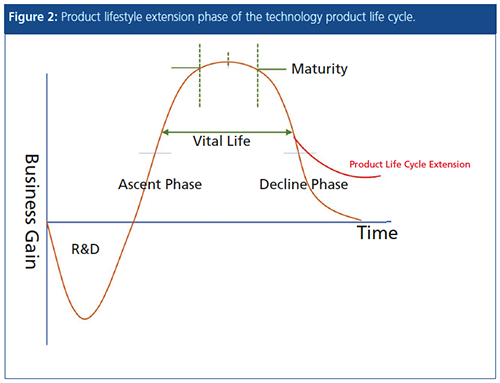How Much Longer Can Chromatography Last?
Incognito is thinking long-term. Is there scope for hope in the future?
jes2uphoto/stock.adobe.com

Incognito is thinking long-term. Is there scope for hope in the future?
As we enter the last six months of the second decade of the 21st century, I want to take the opportunity to briefly reflect on the progress of chromatographic science and look forward to what we might expect in the third and subsequent decades of the century.
However, being Incognito, I’d like to do this in a slightly more challenging way than perhaps would be usual in the popular scientific press.
There is a well-defined model of the technology product development life cycle, which is shown in Figure 1. Most of this figure should be pretty self-explanatory, and whilst it is typically used to define the return on investment of a new technology (usually a single product) from a manufacturing business perspective, I believe it’s a reasonable surrogate for the life cycle of an enabling technology, such as chromatography.

The big question is, where are we currently on the cycle? As you will see in Figure 1, I’ve given my best guess, although I realize that this perspective may be different depending upon if you are a user within a large, well-funded organization, in a smaller, less well funded laboratory, in academia, or working for an equipment or software manufacturer.
So why do I think we are firmly, as chromatographers, reaching the end of the vital life of our industry and entering the decline phase of the technology product life cycle? What does this mean and what does the future hold for us?
Let me begin by stating that I believe we have never been so well off as chromatographers in terms of the quality and range of our equipment, the number of tools we have within our analytical armoury, and our ability to solve previously unfathomable problems. However, this doesn’t mean that we aren’t approaching the end of the vital life of our technology. What makes me say this?
Let’s look at the characteristics of technology in the decline phase, from a business perspective (for which the technology life cycle was designed), and see if these fit with anything we see within our industry today:
- The decline phase is typically characterized by a falling demand for the product or technology. More features, benefits, and capability have been built into each unit and, therefore, more can be done with less.
- In the early part of the decline phase, larger businesses can retain or even grow their profits for several reasons-i: The optimized technology is more reliable and therefore less cost-of-sales need to be attributed to the field maintenance (typically under warranty) of each unit; ii: Whilst research continues into line extensions or minor improvements, the high operating costs of fundamental R&D are largely eliminated; iii: Whilst marketing communications are still necessary to maintain sales volumes, the high costs associated with radical new product launches are very much reduced; iv: Smaller competitor sales reduce to break even or even loss making and they exit the market, with their associated sales switching to the bigger brands whose market share increases, and their sales volumes do not contract as quickly as the market; v: The larger suppliers consolidate their product mix, offering fewer, more capable, platforms and manufacturing costs reduce in line with the number of different products and options offered to the market; vi: Smaller retailers and distributors are eliminated in order to optimize profits on each unit sold and on-line sales channels become increasingly important as the pull rather than push sales models are adopted.
So, what can we glean from this? I know that the chromatographic instrumentation industry tends to follow The Analytical and Life Science Instrumentation Industry SDi report (1), and from glimpses I’ve seen of recent reports, there is still growth for most of the major manufacturers in instrument technology, even if this growth is not as aggressive as has been achieved in the past. Obviously, analytical laboratories all over the world still require new instruments, however, I wonder if, like me, you recognize some of the other symptoms of decline that are outlined above?
There are fewer, smaller instrument companies; instrument platforms have become more reliable; and there are fewer options within manufacturer ranges than in the past. The large companies now dominate the marketplace and tend to have their own sales forces, relying less on distributors or “partners”, and I believe their support teams are less numerous than they have been previously. I can certainly see that the digital channels for sales are increasing, although this also coincides with the advances in webâenabled selling and the increasing reliance and trust that we as consumers have in on-line information gathering and ordering. It also feels like applications and support teams within the vendor market are shrinking, although I’m sure I will get a response that challenges this thinking. Marry this with the decline in fundamental academic research into chromatographic techniques, which ultimately drives (or at least mirrors) the product innovation from the major manufacturers, and one might begin to worry about the future.
It’s useful to consider the truly “enabling” technology and science of recent times, to evaluate the true extent to which our industry is reaching the end of its vital life:
- High performance liquid chromatography–mass spectrometry (HPLC–MS), specifically atmospheric-pressure ionization
- High resolution mass spectrometry (orbital trap and quadrupole time-of-flight [QTOF] being notable examples)
- Triple quadrupole mass spectrometry
- Hydrophilic interaction liquid chromatography (HILIC)
- Ultrahigh pressure (performance) liquid chromatography (UHPLC)
- Core–shell HPLC column packing materials
This is an impressive list and would indicate that my assertion of our position in the technology life cycle is incorrect. Surely, most of these advances are true “game changers” that highlight how our technologies are not even mature, let along on the verge of decline?
There is a well-known phenomenon called the product life cycle extension, the economic model of which is shown in Figure 2.

Here, businesses try to stave off the decline phase of technology by rethinking the positioning of a product or even a whole market by broadening applicability or adding significantly new or improved functionality or utility to the product.
- Simple examples include:
- Mobile phones having high-quality camera features to take market share from the digital camera companies
- Breakfast cereal manufacturers repurposing their products into cereal bars to appeal to their increasingly time-poor customers
- Apple Pay and Google Wallet entering the e-payment market to gain market share via customer loyalty and increasing product combination
Are the enabling technologies mentioned previously merely “extensions” to existing technologies or new innovations that will deliver real business benefits to manufacturers?
To my mind there is only one true innovation in the list and this is HPLC–MS, in that until the mid- to late 1990s it simply wasn’t possible to successfully interface HPLC techniques with mass spectrometric detection. The other technologies offer real improvements, but fundamentally they existed previously and add performance improvements, rather than being fundamentally enabling. Aside from LC–MS, they all follow the product life cycle extension model rather than the full technology product life cycle. Arguable maybe, and no doubt I’ll get some robust challenges to my statements here, but these are my views.
To explain further, let’s consider what I would consider “new” technology that might start the life cycle afresh:
- Handheld (or small and portable) spectrometric or spectroscopic devices able to fully elucidate and quantify the contents of liquids, solids, or gases
That’s it-short and sweet.
Once we have these, there will be no need to separate individual components in order to introduce them into our detectors. Our detectors will have the ability to structurally elucidate even the most complex analytes (large complex proteins, for example) without the need to simplify them (through digestion, for example) or to remove or separate them from their matrices. Of course, most of us will then be out of work, or be working for the megacorps responsible for developing these techniques.
My guess is that we will be there within 25 years, by which time I’ll be “safely” retired. Let’s face it, Star Trek had the tricorder, a device with similar capabilities in the 1960s, but let’s not forget that the series was set in the 23rd century-putting us well ahead of science fiction in this case.
Until then, we will continue to add extensions to our existing technologies, mass spectrometers will become increasingly accurate and sensitive, and chromatography will become ever faster, more efficient, and perhaps even more selective. But we will be extending the technology cycle, not fundamentally reinventing it. So, how safe
is your future career and who should you
be working for in order to be on the analytical tricorder gravy train? I’ll leave you to ponder those fundamental questions.
Reference
- Strategic Directions International: https://strategic-directions.com/product/2019-sdi-global-report-analytical-life-science-industry/
Contact Author: Incognito
E-mail the Editor:kjones@mmhgroup.com

A Final Word from Incognito—The Past, Present, and Future of Chromatography
February 10th 2022After 14 years in print, Incognito’s last article takes a look at what has changed over a career in chromatography, but it predominantly focuses on what the future might hold in terms of theory, technology, and working practices.
Sweating the Small Stuff—Are You Sure You Are Using Your Pipette Properly?
October 7th 2021Most analytical chemists believe their pipetting technique is infallible, but few of us are actually following all of the recommendations within the relevant guidance. Incognito investigates good pipetting practice and busts some of the urban myths behind what is probably the most widely used analytical tool.







